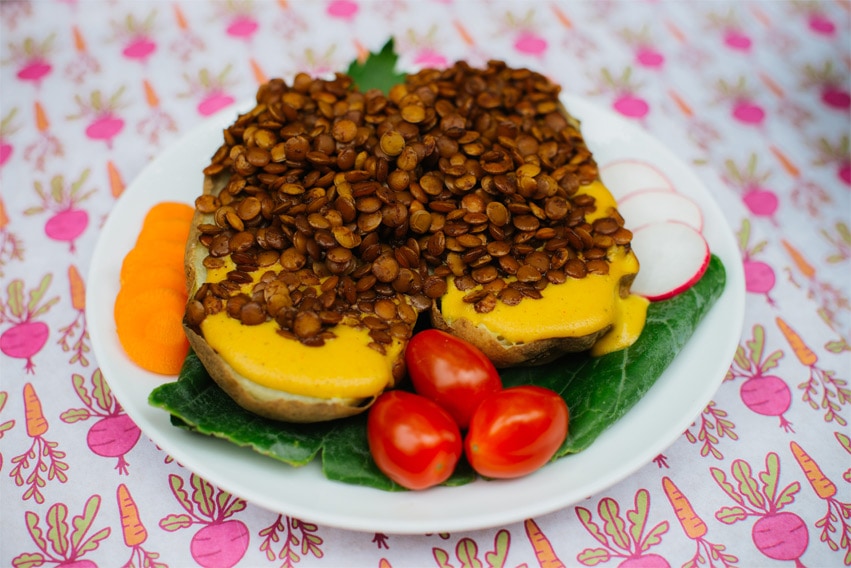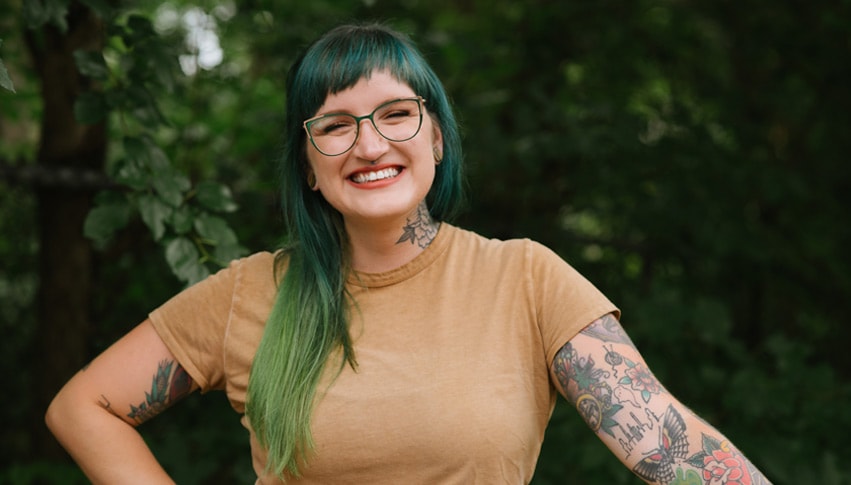In 2017 I was in graduate school, working to earn my MFA in sculpture. I was terribly stressed and sleep-deprived, had very little money, and had a fairly awful diet (as one does in graduate school). That winter, I started experiencing abdominal pain that was so severe at times, it forced me to lay on the floor and wait for it to pass. It came in waves… and seemingly outof nowhere.
Without health insurance and not qualifying for Medicaid, my pain was getting worse. I resorted to Google to try to find an answer. Several resources claimed that a whole-food, plant-based vegan diet could help. My transition to a vegan diet began that day—first by omitting red meat, then chicken, then fish, then working through dairy and other animal products. I knew if I wanted to make this a lifestyle change, I needed to take my time and do it right.
A New Mindset
Rumor had it that a vegan diet was going to be highly restrictive. In the beginning, I focused on the foods I was going to miss, instead of all the new foods that were going to change my life. Being raised in the ’90s, we were often surrounded by “Got Milk” campaigns telling us that milk gives us strong bones and meat gives us the protein we need. Those beliefs stuck with me into adulthood, which, I must admit, is very impactful marketing.
There are so many more resources now which discuss the benefits of a whole-food, plant-based diet without fear-mongering or shaming the viewers. They include books such as How Not to Die by Dr. Michael Greger and Fiber Fueled by Dr. Will Bulsiewicz, podcasts like The Exam Room and documentaries like The Game Changers. In order to change my diet in this way, it was important to be well-versed, passionate, committed and safe about every step.
I was raised on the standard American diet—chock-full of inflammatory foods—so it wasn’t a surprise to feel a significant improvement in only one month. My pain was starting to become manageable, and my cystic acne had completely disappeared. I had increased energy, my mind felt less foggy, and I had lost weight as well.
I was still worried about a protein deficiency, however, because I, too, bought into the idea that I needed to closely monitor my protein intake with the decision to omit meat and dairy. But not only do most people in the U.S. get plenty of protein, I learned that a protein deficiency is incredibly uncommon. When people ask where I get my protein, my answer is simple: it’s the same place anyone gets their protein—from plants. All protein (even the protein found in meat) originates in plants.
Plants also contain essential amino acids in varying proportions, as well as other important nutrients that aren’t found in meat and dairy, such as dietary fiber, vitamin C and flavonoids (or antioxidants). It is safe to get all of our protein from plant sources such as whole grains, vegetables, beans, nuts and soy. In addition, omitting animal products from our diet reduces the risk of coronary heart disease, stroke, chronic disease, diabetes, cancer and more.

Myths of Dairy
“Milk does the body good” is a slogan most of us have heard over the years. We’ve seen celebrities rocking their milk mustaches and were taught that dairy was one of the major food groups. We believed that milk alone gave us strong bones. So, can we still get enough calcium if we aren’t consuming cow’s milk? Absolutely. In fact, eating green, leafy vegetables helps our bodies absorb calcium at a higher rate than consuming cow’s milk—and without the inflammation.
Growing and maintaining strong, healthy bones comes from calcium, vitamin D, magnesium, vitamin C, vitamin K and potassium—all of which can be found in plants. Some of my favorites include broccoli, Brussels sprouts, kale, chickpeas, tofu, tomatoes, kiwi, bananas and potatoes. I enjoy sitting outside with a rainbow of foods in the sun to catch some vitamin D.
Dairy is by far the most difficult item to omit from our diets because it is, quite literally, addictive. In his book, The Cheese Trap, Dr. Neal Barnard explains that dairy proteins act as mild opiates, which is a significant reason why it is so hard to give up cheese. Cheese is such a large part of the standard American diet that completely omitting it overnight isn’t sustainable. It’s important to find satisfying replacements: like mac and cheese made out of cashews, nacho cheese made from chickpeas, midwestern casseroles made from sweet potatoes with nutritional yeast, or parmesan made from almonds.
Taking the Journey
Eating vegan is not always healthy. With the recent increased interest in vegan, plant-based eating also comes processed meat and cheese alternatives. These options can make going vegan more approachable and accessible to others, but they do not supply all of the nutrients our bodies need. I suggest thinking of them as a treat from time to time, instead of a staple in our diets.
If you would like to reduce your intake of animal products, I encourage you to take it one step at a time and never beat yourself up for a mistake. Know how to identify a credible source, and take advantage of these new alternatives while you find whole foods and plants that you enjoy. Find resources and supportive communities that keep you interested and motivated, and try at least one new produce item that you find at the local farmer’s markets or grocery stores each week. PM
Jam Rohr is the owner and operator of Up Beet Jams, a vegan, plant-based meal service. For more information, visit upbeetjams.com.




